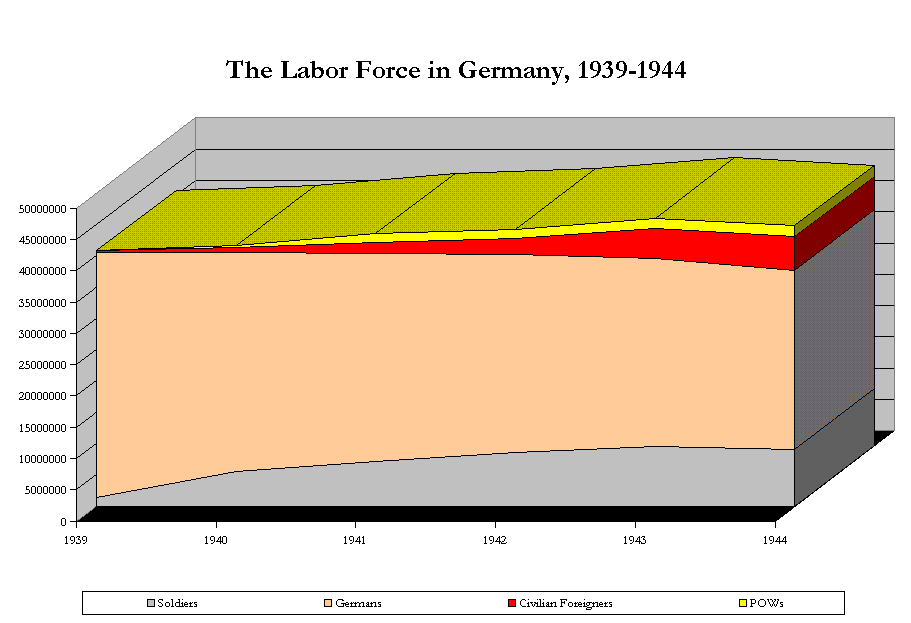
This chart suggests the measure of dependence on foreign labor which Nazi Germany developed during the war, mostly because of the manpower drain resulting from military service but also as a result of the regime's hesitance to employ the female population fully. Although the percentage of German women employed in 1939 and after was higher than in either the United States or Britain, that number increased only slightly in Germany after 1939, whereas in the other two it shot up dramatically. In a certain sense, then, foreign labor was a substitute for women's work. But it was not enough: the military consumed an ever larger share of the available pool, so that even with the addition of civilian conscripts and POWs, the civilian labor force steadily decreased.
The following chart gives an idea of where foreign laborers were coming
from:

In 1944, the largest proportion were Soviet citizens, either conscripted civilians or prisoners of war. It had not always been this way. In 1939, the foreign labor pool consisted almost entirely of Poles, and many of these were seasonal laborers—a pattern that reproduced already long-standing seasonal labor migration patterns between the two countries, Germany and Poland. The addition of Polish POWs to this pool swelled the foreign labor force to 1,200,000 by the autumn of 1940. In the same year, labor deployment authorities expanded recruitment of workers to western European countries and began employing French POWs as well.
The greatest transformation in the foreign labor pool came, however, in 1942, after the invasion of the Soviet Union. Initially, the Army and the civilian occupation authorities did not attempt to employ the legions of soldiers taken captive in “Operation Barbarossa”—the attack on the USSR—and as a result of this decision over 1.4 million prisoners of war had died of starvation, exposure, and disease by the end of 1941, some 60% of the total. But in the spring of 1942 the German authorities switched to “deploying the Russians” (Russeneinsatz), civilians and POWs alike. By the end of 1942, almost as many civilians were conscripted in the occupied territories (1.3 million) as the number of prisoners who had died the previous year; in addition, about half a million POWs were deployed for labor in Germany as well, the majority in agricultural work.

This chart clearly shows the effect of the regime's decision not to
mobilize the female workforce any more than it already was in 1939. While
the overall civilian German workforce steadily declined during the war
years, the number of women in it remained constant. Percentages can be
deceiving: from the perspective of German women, the greatest changes in
the distribution of labor came before the war began. The national trend
was reflected in the experience of individual businesses, such as the Siemens-Halske
electronics concern in Berlin. Although the war years brought a general
expansion in the firms workforce, the percentage of women in it grew more
before 1939 than after; indeed, from late 1942 on, their proportion went
into decline:

Source: Ulrich Herbert, Fremdarbeiter: Politik und Praxis des "Ausländer-Einsatzes" in der Kriegswirtschaft des Dritten Reiches (Berlin: Dietz, 1985); Wolfgang Michalka, Das dritte Reich, vol. 2., Weltmachtanspruch und nationaler Zusammenbruch, 1939-1945 (Munich: dtv, 1985).
Return to 443/543 Homepage